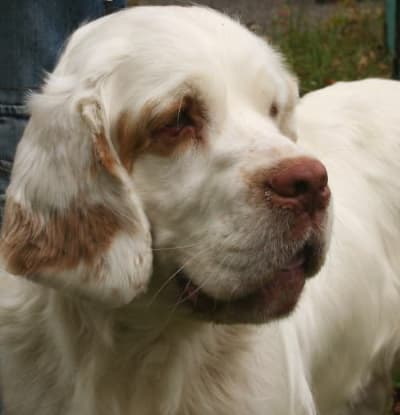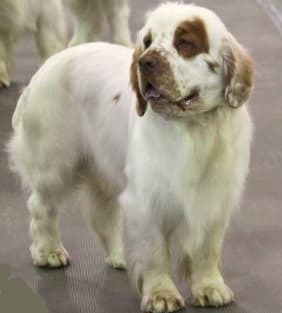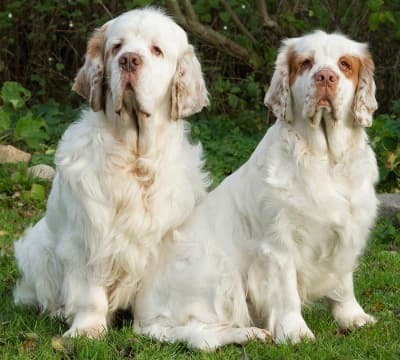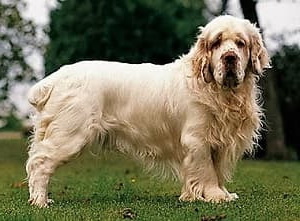Clumber Spaniels
Dignified, Gentle And Loving!
Clumber Spaniels are accomplished hunting dogs and have been associated with sporting life for over two hundred years, though the actual details of the breed's origin are still debated.
There is wide belief that this somewhat rare breed was developed in Nottinghamshire, England and took their name from Clumber Park in that region. Another account suggests they originated in France and came to this northern part of England via a French aristocrat who, supposedly, brought similar dogs over during the revolution.

The Clumber, also known by the unusual name of "Retired Gentleman's Spaniel", does not have a typical spaniel appearance, being very large-boned, long and heavy-set in his body. He is also lower to the ground, has a very large head, broad muzzle and strong thick neck.
From his physical attributes, it is easy to accept the notion that there was some blending of both the Basset Hound and alpine spaniels - such as the St Bernard, in his development.
The facial lines and kindly
expression are very reminiscent of the latter. Clumber Spaniels have the
distinction of being the largest flushing-type spaniels and were
recognized by the American Kennel Club in 1884 as part of the sporting dog breeds.
If you have a Clumber spaniel, or are knowlegable about this somewhat rare breed, you're invited and encouraged to share your insider information here on the website.
Physical Stats And Care Of Clumber Spaniels
Height: 19-20 inches
Weight: 55-85 lbs
Color variations: Predominantly white with lemon orange markings.
The Clumber's abundant coat is straight, silky, quite dense and weather resistant. It does shed year round and at times quite heavily.
Regular grooming will help keep your home from an abundance of furballs. Use a high quality pin brush and a coarse tooth buttercomb
to remove loose hair and any accumulation of debris from outdoor
activities which may become attached to the heavy coat. This will be a
big help in dematting and detangling the coat.
An excellent tool to deal with periods of heavy shedding is the FURminator.
Because Clumbers are susceptible to eye conditions, their eyes need to be inspected regularly and kept clean. They are also prone to ear infections
can because the long ears of the breed inhibit air circulation and trap
moisture, setting up ideal conditions for bacteria to flourish. For
this reason, they need routine inspection, cleaning and be kept free of hair.

Clumber Spaniel Health Notes
Lifespan of the Clumber Spaniel averages 10-12 years - not very long when compared to similar size dogs. This apparently is due to the small gene pool resulting in more inbreeding.
There are some health issues to be aware of that are associated with the breed.
They include:
- Hip Dysplasia
- Elbow Dysplasia
- Intervertebral Disc Disease
- Entropion
- Hypothyroidism
- Ear Infections
- Cataracts
Testing can be done by breeders for some of these diseases and results/certificates should be provided to prospective buyers.

Characteristics Of The Clumber
Clumber Spaniels have a reputation for being reliable, calm and dignified in their demeanor. They are considered ideal family companions, being very gentle and extremely loving toward their master. The loyalty of the breed makes them useful as watchdogs though they are not nuisance barkers.
The Clumber is eager to please, very intelligent and easily trained for hunting, tracking and retrieving. But, they can be a tad stubborn during training.
Since the breed is more than fond of food, treats could be used on a temporary and limited basis during training to get them motivated!
His very keen sense of smell coupled with a slow and stealthy approach, enables him to sneak up on his quarry without detection. His white coat helps him to be seen by humans in hunting situations.
The Clumber Spaniel is an efficient retriever both on land and water. His very dense double coat protects him in heavy brush as well as in pursuit of duck in cold water.
These spaniels have healthy appetites and enjoy food. It is recommended that owners keep an eye on the scale to make sure their dog stays within a healthy range for its size.
How Active Are Clumber Spaniels?
The Clumber's orientation has been as a working dog enjoying plenty of outdoor activity. As such, he needs regular exercise to satisfy the call of the wild and to stay healthy.
Inside the home, the Clumber frequently seeks out the couch, but if
allowed to become too sedentary, this breed has a tendency to gain
weight.

Space Needs
Clumber Spaniels do best in a home with a significant yard and plenty of room to run about.
Apartment living might be too hard on them as well as confining for a breed that enjoys the great outdoors!
That being said, given sufficient exercise, they won't be fussy about space. And, on the plus side, if you do have close neighbors, the Clumber is generally not a barker.
Does The Clumber Enjoy Children?
Yes, this breed has an excellent reputation with children, being very playful and patient.
However, because children and dogs can be unpredictable it's always wise
to play it safe and have adult supervision whenever they are
interacting.
Is The Clumber Suited To Senior or Sedentary Families?
The loving and loyal nature of Clumber Spaniels make them ideal companions for seniors or less active families, providing a couple of thirty minute walks can be provided.
Ideally the home would have an outside area of sufficient size where the Clumber could spend some time each day.

Recommended Book Resources:

Covers everything you need to know about owning, breeding and raising Clumbers.
Includes development of the breed, standards, choosing and getting a
dog, exercise, living accommodations, feeding, grooming and health,
training, breeding considerations, whelping and raising Clumber
Spaniels.
Extensively illustrated.
Resources: Creative Commons and Wikimedia
Clumber Spaniel Club
Wikipet
- Home ›
- Dog Breeds ›
- Sporting Dog Breeds › Clumber Spaniels

